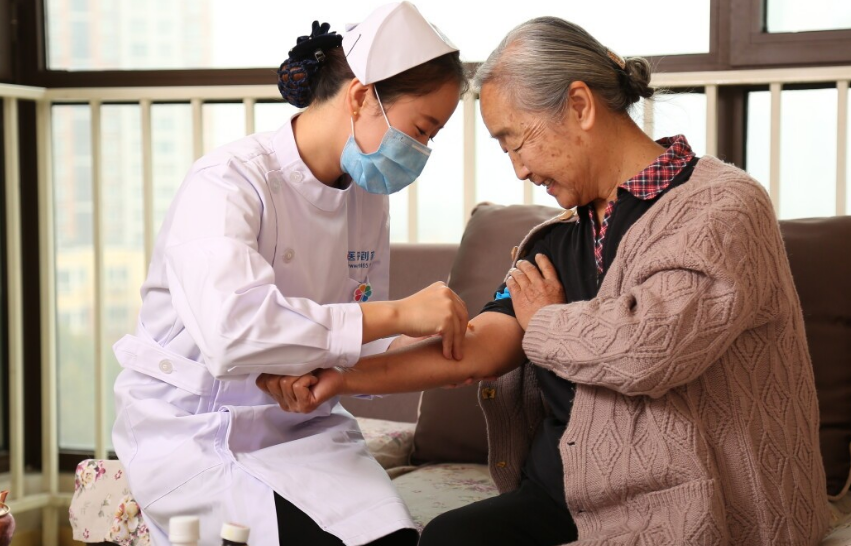Application advantages and development status of emerging nursing robots
1. The significance and future space of nursing robots
"A Robot in Every Home." As Bill Gates has said, robots will become as much a part of our daily lives as the personal computer industry. Throughout the world, the rapid arrival of industrialization, urbanization, aging population and great changes in family structure have made many countries more and more pressure on old-age care and disease care. The traditional nursing model no longer meets the social needs of population increase and slow aging, advanced lifestyle and nursing model are slowly improving human life, and nursing robot is highly respected because of its intelligent and multi-functional future development trend.
1.1 The aging of society is worsening
At present, there are about 1.041 billion elderly people in the world, and population aging has become a major social problem in the world. At the current rate, by 2100 there will be three times as many people as there are now, and there will be three billion more. The degree of aging in developed countries will be more prominent, and the elderly over 60 years old in developed countries in Europe and the United States now account for about 23.3%, and will reach 33.4% by 2050. The number of elderly people in developing countries is expected to double by 2050. The rapid growth of aging in developed countries has caused many problems for economic and social development [1]. Most of these elderly people have decreased physical function and vitality, and they face many difficulties and obstacles, such as no care for daily life, no timely treatment of diseases, and no relief from negative emotions. More and more elderly people need timely nursing services to ensure safety and social stability, which is a serious challenge to the cause of old-age care and nursing.

1.2 Impaired health of the elderly
Taking China as an example, according to the statistics of the Ministry of Health, about half of the elderly over the age of 60 in China suffer from hypertension, and about 80% of the elderly suffer from at least one or more chronic diseases. The proportion of self-reported chronic diseases among the elderly in urban communities accounted for 79.91%; The self-evaluation of health status was good only 20.25%, and poor 42.30%[2]. The disabled people, mainly the elderly, face a variety of difficulties in life and work, and most of them have decreased physical function and are plagued by diseases.
1.3 Insufficient social care force
Faced with such a large number of disabled people, the nursing industry in our country is facing great pressure. According to the third Straits Nursing Forum data show that in December 2011, the total number of registered nurses in China was 2.244 million. Since the elderly population reached 143.244 million as early as 2006, it is clear that caregivers cannot complete all the care work. According to the Ministry of Civil Affairs, as of April 2013, China's urban and rural elderly care institutions have about 3.65 million beds, far from enough for the elderly. China's nursing service industry is facing severe challenges, directly stimulating the domestic nursing robot market. The society is in urgent need of intelligent equipment in nursing, which is applied to families and nursing homes, and the more professional nurses can not care for the body and mind of the elderly, so that they can happily integrate into modern life.
1.4 Rapid development of the robot industry
Robot is a kind of interdisciplinary high-tech products, which involves kinematics, dynamics, control engineering, materials science, artificial intelligence and other disciplines. The growth process of robot is the creation, improvement and comprehensive configuration process of computers, sensors and various institutional systems.
Today, robots have developed from the first generation of teaching and reproducing robots, the second generation of robots with feelings to the third generation of intelligent robots. At present, foreign scientists have made great progress in mobile mechanism design, sensor fusion and environmental modeling technology, path planning technology, energy technology, intelligent control technology, human-computer interaction technology, cost control and other aspects [3].
2. Development advantages of nursing robots
2.1 Improve the quality of life of the elderly
There are many diseases in the elderly, and the robot can act as a disease recorder and medical file record library, which can allow doctors to have a more complete understanding of the condition, so that they can make more accurate guidance. Because the monitoring robot does not need to rest, and can be continuously monitored for a long time in the process of work, and through its own sensors and other monitoring equipment to observe the monitoring object, and collect the corresponding physiological characteristics information, and finally store it, which is convenient for follow-up targeted treatment and analysis of the elderly. This is conducive to the elimination of diseases in the elderly.
The nursing robot also has a remote transmission function, which can upload the information it collects in real time. The doctor only needs to receive the medical information uploaded by the robot device to treat the patient without leaving the house, and the patient can also communicate with the doctor directly through the robot communication network. This not only saves the time on the way to the hospital, but also ensures the best period of disease treatment to a large extent, which plays an important role in ensuring the health of the elderly. Especially for those elderly people with mobility difficulties, the role and advantages of home care robots are particularly obvious. At the same time, this real-time telemedicine achieved by home care robots not only achieves the purpose of improving the efficiency of medical care by traditional telemedicine, but also can overcome the problem of low accuracy of traditional medical care.

Care robots can also address the physical limitations that the elderly usually have, and robotic devices can play a role in assisting activities, such as helping to get up and helping to pass items. In view of the decline of the memory ability of the elderly, a reminder service can be set for the robot to improve the social life ability of the elderly. Of course, for some emergencies, robots can also act as emergency rescue tasks and so on. These functions of robots are particularly important for the physiological health monitoring and home care of the elderly [5].
2.2 Liberating the labor force
The advantage of nursing robots is also reflected in their impact on society. Due to the rising cost of labor, people are eager to get rid of the boring and repetitive tedious labor and do something more meaningful. The service and care of the elderly is a long-term process, which is to some extent a waste of resources for the caregivers. For some families, if there are elderly people in need of care at home (especially sick elderly people), it will cause more or less of a burden to other family members, and the appearance of care robots will greatly reduce their time to take care of the elderly. For the whole society, it can solve the social security problem of the aging society, promote social harmony, and provide a good environment for economic development.
The application of service robots in the care of the elderly can not only liberate a group of labor, but also promote the development of the robot industry and promote the industrialization and marketization of robots. The application of robots in the tertiary industry can make certain contributions to the adjustment of industrial structure and promote the stable development of national economy [6].
3. Development status of nursing robots
3.1 Development status of nursing robots in foreign countries
The application of robots in medical and home health care is regarded as the most explosive new market for the robotics industry. The output value of nursing robots accounts for about 10% of the overall robot industry, second only to military, agricultural and construction robots, and the overall output value ranks fourth. There are more than 10,000 professional nursing robots in use worldwide.
According to market research, there are five main types of nursing robots: rehabilitation assistance, medical support, spiritual comfort partners, home health care and medical surgery robots. For these five categories of care robot products, a comparative analysis of the existing products in their markets is also carried out, as shown in Table 3.1.2.
The development of nursing robots in foreign countries is many years earlier than that in China, and the prototype of this robot has appeared as early as the 1940s, but the robots studied at that time are still far from providing nursing services. The real appearance of robots with nursing service functions was 40 years later in the 1980s. Since the 1990s, many countries have carried out research with their own characteristics, and a variety of nursing service systems have emerged, such as intelligent wheelchairs that can compensate for walking ability, intelligent nursing beds for disabled people, and robotic systems to help patients recover.
(1) Nursing robots in Europe: In the mid-1970s, the Spartacus operator project in France to help high paraplegic patients and the Heidelberg project in Germany opened a new chapter in service robots. In the late 1970s, the United Kingdom adopted a series of measures to support the development of robots and encourage the research and application of robots, ushering in a prosperous period of service robot research and development. In 1982, the Netherlands developed the experimental manipulator RSI, which can feed food and turn books on a saucer, laying the foundation for the production and use of the wheelchair manipulator Manus in 1984.
(2) Nursing robots in the United States: the United States is the first country to research and produce nursing robots, is the birthplace of a variety of robots, and has a large number of world-class robot design and manufacturing companies.
After the United States entered the 1980s, the government and the business community really paid attention to robots, encouraged robot research and development, formulated development plans, increased investment, and launched a considerable number of service robot products on the market.

In 1984, HelpMate, a typical representative of nursing robots, was born. This is a fully autonomous mobile robot system, which is installed with a variety of sensors, has obstacle avoidance function and autonomous navigation function, and can operate a designated destination through a human-machine interface to complete tasks such as delivering medicine, food, and medical records. Helpmate opens doors and has access to the elevator. At present, 80 hospitals around the world are using it.
In 1985, the "nurse assistant" robot began to develop, and in 1990, it was put into production and sales, and is used in dozens of hospitals around the world. It can create convenience for patients: sending medical records, delivering meals, and can also become a small helper for nurses: transporting medicines, medical equipment, etc.
(3) Japan's nursing robots: Japan is known as the "kingdom of robots" reputation, entertainment robots, guide robots, cleaning robots and other robots widely participate in all aspects of people's lives. Compared with other countries, Japan's nursing robots have large output, multiple functions and a wide range of applications. Japan has made it a national policy to promote the development of household robots, and has formulated a "technical strategic blueprint" to plan the development of robots.
Since the introduction of robots and technology from the United States in the 1960s in Japan, after the development of the 1970s and 1980s, the aging trend in Japan is obvious, and the Japanese government began to attach great importance to the research and development of nursing robots. The "National Technology Strategic Plan" issued by the Japanese Ministry of Economy, Trade and Industry predicts that care robots will gradually enter the life of ordinary families. In addition to the government's attention, a large number of manufacturing research and development companies in Japan have developed nursing robots, established automated production lines of robots, and become integrated suppliers of logistics and warehousing automation equipment. The Japan Robotics Association estimates that Japan's domestic robot market share will reach 931 billion yen in 2025, mainly in the medical care and welfare services sector. The association hopes that when the problem of aging society becomes serious, smart devices can serve the elderly.
In 2005, in order to provide living support for the elderly, a Japanese company developed two household robots, "companion" and "recognition". With multiple built-in microphones and advanced image and voice recognition technology, the two robots can understand user commands and automatically follow users.
(4) Nursing robots in South Korea: South Korea has high independent intellectual property rights of robot technology and launched a national strategic development of robots, service robots as a development focus. South Korea has given key support to service robot technology, and has identified intelligent service robots as one of the nine new growth engines to promote national economic growth in the 21st century, and strives to make it a new economic growth point. Research on the design and development of service robots and set off the trend of developing service robots in Korea. Android robot, a humanoid robot developed by South Korean scientists, has real-time data transmission, sound and image power sensors, high-speed processors and other technologies, with ranging, voice recognition, processing command signals and interaction with the surrounding environment and other functions.
3.2 Development status of nursing robots in China
In recent years, with the support of the "863" program, China has carried out a lot of work on the research and development of service robots and made some achievements. In addition to state support, various enterprises and universities have set up research teams, and the research results of robots in various fields have gradually become fruitful. At present, the service robots developed in China mainly include medical robots, cleaning robots, entertainment robots and so on. For example, the robot team of the University of Science and Technology of China "Kejia" can cook food for people, and the intelligent service robot developed by the Harbin Institute of Technology can pour water for patients, feed medicine, communicate with patients simply, sing and dance.

In November 2010, the first personal hygiene care robot in China was successfully developed. This nursing robot mainly uses intelligent control based on fuzzy theory, ergonomics and other technologies to provide a full set of bathing services for the elderly and disabled people with mobility difficulties.
In 2008, a university in Taiwan developed "ROLA," an intelligent robot for home care. ROLA has voice recognition and conversation ability, can recognize faces and locate the user's location, and always accompany the user. The robot can recognize the indoor environment and has the function of avoiding obstacles. In addition, the development team is studying the robot's support function, so that elderly people can walk with the robot according to their own will.
In March 2011, a robot laboratory in Shanghai developed the "Jiaolong" robot. The "Cross dragon" robot is suitable for the elderly and welfare homes with no one to take care of it. The whole body is white, and there is an operable electronic display in front of the body, which has the functions of reminding the elderly to take medicine, take medicine and bring water. It can not only serve the elderly, but also serve as a welcome and tour guide for shopping malls and exhibition halls.
In addition to these, the National Rehabilitation AIDS Research Center has also taken the lead in the development of many cutting-edge domestic products, such as orthopedic prosthetics, three-position intelligent wheelchairs and service robots. At present, although our country has made progress in the development of service robot, there is still a gap with the developed countries.
3.3 The gap between the current nursing robot and the expectation
Throughout the development process of nursing robots, nursing robots have slowly begun to grow, but their growth process is relatively slow, and the main reasons for its nursing industry are [7] :
(1) The nursing industry has not received high attention and the government has not paid enough attention to it;
(2) The use environment of nursing robots is limited;
(3) The cost of nursing robots is high, and people's consumption level is limited;
(4) The knowledge level of the audience of nursing robots is low;
(5) There are few talents in nursing field;
(6) The industry lacks a perfect nursing robot design method and evaluation mechanism.
In addition, from the perspective of practical application and technology, there are still two problems to be solved:
(1) Safety: The nursing robot lacks a humanized concept in caring for the elderly, and it may not be able to truly meet the spiritual and physiological needs of the elderly, so it may bring some inconvenience to the elderly. Not only that, the system of the service robot needs regular inspection and long-term maintenance, otherwise, the error of the system may endanger the health and life of the elderly.
(2) Economically: the price of care robots is too high, making it difficult to enter ordinary families, and many ordinary families are difficult to bear the high price of service robots. In addition, the concept of the elderly is relatively backward, the ability to accept new things is poor, the service robot is not easy to accept, and it is likely to produce a repellent attitude. [6]

4 Summary
After nearly 40 years of development, nursing robots have gradually entered people's vision, and its development will continue to change the traditional family nursing and old-age care methods. Although the current level of technology is not high enough, we believe that with the innovation and breakthrough of home robot technology, it is becoming a new development industry. In order to make household robots recognized by more people and used more widely, manufacturers and scientific research institutions need to work together.
In view of the current main research hotspots of nursing robots, in order to meet the adaptability and reliability of nursing robots in complex environments, nursing robots will develop in the direction of intelligence and autonomy. In order to reduce the development threshold of nursing robots and accelerate their development, it is necessary to have a unified open source hardware and software platform for nursing robots [8]. We can combine the current social environment and technical level, first grasp the market operation of low-end robots, and then steadily develop the high-end market, so that care robots can have a better development situation.
Based on the comprehensive analysis of the advantages of nursing robots compared with traditional human nurses at home and abroad, this paper points out the application and technology improvement trend of nursing robots. With the increase of the global aging population, the demand for care robots is also increasing, which can be expected to provide a broader market space and development opportunities for its development.
- EMERSON
- Honeywell
- CTI
- Rolls-Royce
- General Electric
- Woodward
- Yaskawa
- xYCOM
- Motorola
- Siemens
- Rockwell
- ABB
- B&R
- HIMA
- Construction site
- electricity
- Automobile market
- PLC
- DCS
- Motor drivers
- VSD
- Implications
- cement
- CO2
- CEM
- methane
- Artificial intelligence
- Titanic
- Solar energy
- Hydrogen fuel cell
- Hydrogen and fuel cells
- Hydrogen and oxygen fuel cells
- tyre
- Chemical fiber
- dynamo
- corpuscle
- Pulp and paper
- printing
- fossil
- FANUC
- Food and beverage
- Life science
- Sewage treatment
- Personal care
- electricity
- boats
- infrastructure
- Automobile industry
- metallurgy
- Nuclear power generation
- Geothermal power generation
- Water and wastewater
- Infrastructure construction
- Mine hazard
- steel
- papermaking
- Natural gas industry
- Infrastructure construction
- Power and energy
- Rubber and plastic
- Renewable energy
- pharmacy
- mining
- Plastic industry
- Schneider
- Kongsberg
- NI
- Wind energy
- International petroleum
- International new energy network
- gas
- WATLOW
- ProSoft
- SEW
- wind
- ADVANCED
- Reliance
- YOKOGAWA
- TRICONEX
- FOXBORO
- METSO
- MAN
- Advantest
- ADVANCED
- ALSTOM
- Control Wave
- AB
- AMAT
- STUDER
- KONGSBERG
- MOTOROLA
- DANAHER MOTION
- Bently
- Galil
- EATON
- MOLEX
- Triconex
- DEIF
- B&W
- ZYGO
- Aerotech
- DANFOSS
- KOLLMORGEN
- Beijer
- Endress+Hauser
- MOOG
- KB
- Moxa
- Rexroth
- YAMAHA
- Johnson
- Westinghouse
- WAGO
- TOSHIBA
- TEKTRONIX


Email:wang@kongjiangauto.com



































































































































